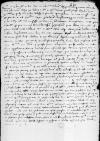⌊⌋, quarum ⌊⌋.
Quibus mihi scribit dedisse se, secundum exemplum a me missum, litteras ad ⌊pontificem⌋ et ad ⌊cardinalem ⌊Regni⌋ protectorem⌋, duplicatasque, ut vocant, earundem, quas accepi, ad me misisse. Precatur mihi felicitatem translationi meae congratulando, pro qua in me benevolentissima propensione, quas debeo, non possum, sed, quantum vires meae valent, Dominationi Vestrae Reverendissimae iterum atque iterum gratias habeo, remittoque in next line⌈queque in next line⌉ easdem duplicatas cum ⌊hoc fratre meo⌋ ⌊Georgio Hegel⌋, ut ille eas certus de auro, quod ⌊dominus electus⌋ et ego ⌊Thoroniae⌋ deposuimus[1], unacum cambii litteris ⌊Romam⌋ mittat, quo tandem semel istius comoediae finem habere possimus. Ceterum, Reverendissime mi
Domine, quod questus sum aliquoties, quibus modis in mea prima expeditione ⌊Romae⌋ tractatus sum, refricare cogor iterum. Extorta fuit a me iniquissimis modis antiqua, ut vocant, taxa, qua episcopatus hic Culmensis septingentis ducatis est oneratus tempore concilii Constanciensis[2], cum in ⌊Prussia⌋ florerent omnia, episcopatus vero Varmiensis duntaxat ad quadringentos ducatos fuit astrictus. Hinc certa est coniectura in proventibus episcopatum Culmensem tum longe fuisse ditiorem Varmiensi. Quod post bella praeterita[3] quantum mutatum sit, ipsa res testatur – in pecuniis paratis, quae ex reditibus dantur, ecclesia Culmensis, quod sancte affirmare ausim, non habet tantum, ut taxae veteri septingentorum ducatorum respondeat – a me tamen et taxa illa integra, ac paene tantundem pro bullarum expeditione contra tum ⌊Florentinos⌋, in quos ⌊pontifex⌋ saeviebat[4], fuit rapta, nedum extorta. Quod ne ⌊successori meo⌋ fiat, a Dominatione Vestra Reverendissima quantum possum oro impensius, ut a ⌊maiestate regia⌋ eius tenoris litteras, ut scheda habet inclusa, et ad pontificem, atque ad cardinalem
protectorem obtineat, quas frater hic meus medio ... illegible⌈...... illegible⌉ ⌊Georgii Hegel⌋ ⌊Romam⌋ mittet. Quae sive profecerint, sive infecerint, nihilominus tamen ⌊dominus electus⌋ et ego quoad eius fieri poterit, gratissimi semper Dominationi Vestrae Reverendissimae sumus futuri. In ⌊⌋, in quo se ita acturam pollicetur, quod satis desiderio meo fieri debeat. Si itaque resignationem meam, quam misi, Dominatio Vestra Reverendissima retinuit, ne prodeat in effectum, velit hoc fratri meo indicare, cui commisi habita voluntate Dominationis Vestrae Reverendissimae, quid illum facere oporteat. De nostra hic contributione iam tempus exposcit, ut mandata regia mitterentur, sine quibus nescio si quid incipi possit. cf. Adagia 1526 No. 1092 Battologia, Laconismus; Cic. Fam. 5.3.2 ne vobis multitudine litterarum molestior essem; Cic. Att. 10.5.2 tamen nihil praetermittam. atque utinam tu, sed molestior non ero; Cic. Fam. 4.5.6 finem faciam scribendi; Cic. Att. 10.8.1 finem inter nos scribendi fieri tempus esse ⌊Et ne
battologiis meis, ut soleo, in praesentia sim molestior, finem facio ms. battalogiis(!)
⌈Et ne
battologiis meis, ut soleo, in praesentia sim molestior, finem facioEt ne
battologiis meis, ut soleo, in praesentia sim molestior, finem facio ms. battalogiis(!)
⌉cf. Adagia 1526 No. 1092 Battologia, Laconismus; Cic. Fam. 5.3.2 ne vobis multitudine litterarum molestior essem; Cic. Att. 10.5.2 tamen nihil praetermittam. atque utinam tu, sed molestior non ero; Cic. Fam. 4.5.6 finem faciam scribendi; Cic. Att. 10.8.1 finem inter nos scribendi fieri tempus esse ⌋, et me benevolentiae Dominationis Vestrae Reverendissimae summopere commendo. Quam dominus Deus sospitet ac prosperet in omnibus.

 BCz, 244, p. 291
BCz, 244, p. 291